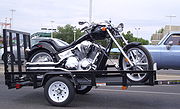
Motorcycle trailer
Encyclopedia



Trailer (vehicle)
A trailer is generally an unpowered vehicle pulled by a powered vehicle. Commonly, the term trailer refers to such vehicles used for transport of goods and materials....
used either to carry motorcycle
Motorcycle
A motorcycle is a single-track, two-wheeled motor vehicle. Motorcycles vary considerably depending on the task for which they are designed, such as long distance travel, navigating congested urban traffic, cruising, sport and racing, or off-road conditions.Motorcycles are one of the most...
s or to be pulled behind a motorcycle in order to carry additional gear.
For carrying motorcycles
Motorcycle carrying trailers may be open or enclosed. They may be wide, for two bikes side-by-side, or narrow, for just a single bike. The main features that distinguishes them from other flatbed or enclosed trailers are track(s) to keep the wheels from sliding side to side and sufficient tiedown points to keep the motorcycle(s) from tipping. They may also tilt, or include ramp(s) to facilitate the loading and unloading of motorcycles. Trailer manufacturers often offer trailers specifically designed for carrying motorcycles.Enclosed trailers, as seen in the photos, have the advantage of protecting motorcycles within from the weather and from prying eyes, and of being able to lock the motorcycles up securely. However, they are heavier than open trailers and create more wind resistance, decreasing the mileage of the towing vehicle. An enclosed motorcycle-specific trailer can be built low enough so as not to increase resistance due to wind, and therefore mileage, substantially.
Collapsible or folding motorcycle trailers are available to overcome storage problems that might prevent use of a non-collapsible trailer, some such trailers are sufficiently compact to allow the user to carry the trailer in the trunk of a car when not in use.

For being pulled by motorcycles
Trailers towed behind motorcycles are distinguished by their relatively small size, especially narrow wheelbase. They are also often styled to match the look of the motorcycle they are intended to be towed behind. This styling can include the overall shape, fender shape, lights, chrome, etc.The Guinness World Record for a motorcycle and trailer is 139.5 mph, set in 2002 by Motor Cycle News (UK) towing a Squire sidecars
Squire sidecars
Squire is a British manaufacturer of motorcycle sidecars that pioneered the design of the modern motorcycle trailer for being pulled behind a bike in the early 1980's...
D21 trailer behind a Kawasaki ZZ-R1100.
In the United Kingdom there are some legal restrictions on towing trailers.
Only motorcycles over 125 cm³ (7.6 cu in) may tow, the bike must be marked with its kerbside weight, the trailer must not be wider than 1 metre and the distance between the rear axle of the motorcycle and the rear most part of the trailer must not exceed 2.5 metre. The laden weight of the trailer must not exceed 150 kg (331 lb) or two-thirds of the kerbside weight of the motorcycle.
Safety tips for towing include:
- Motorcycle manufacturers do not recommend that trailers be towed by their motorcycles because of the increased safety hazards. All towing is done at the operator's own risk.
- "While towing your trailer, you must remember to ride closer to the center of the road. You have the width of your trailer to worry about. Be careful of the "oil strip" in the center of the road at intersections. Also, watch for uneven road surfaces and road edges which can unbalance the trailer."
- It is important to "keep enough of the weight forward of the axle center point to maintain a positive hitch load" when loading the trailer."
The Pav 40/41/100:
The Pav trailers were manufactured in the Czech Republic, originally by "AVIA n.p". and later by "KOVOZAVODY SEMILY" by Jawa Motors
Jawa Motors
Jawa is a motorcycle manufacturer in the Czech republic, formerly Czechoslovakia. The name was created after its founder, Frantisek Janecek, bought the motorcycle division of Wanderer in 1929 , by concatenating the first letters of Janeček and Wanderer...
. Earliest examples made in the mid to late '50s, which pre-date the PAV 40. The PAV 40 debuted in approximately in 1958 or 1959. At some point the PAV 41 replaced the PAV 40 and was produced into the 70's. Pav trailers feature a 4 inches (102 mm) wheel and are rated to 80 km/h (49.7 mph). They were made to be attached to Jawa motorcycles, although they make excellent accessories for Vespa, Lambretta, Cezeta, Heinkel, Fuji, Zundapp, Cushman, or any other vintage motorcycle, scooter or microcar (like Isetta or Messerschmitt).

